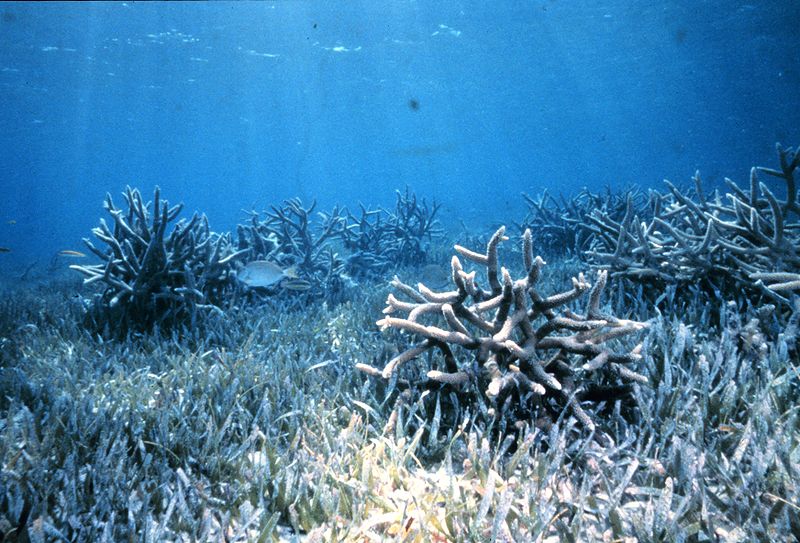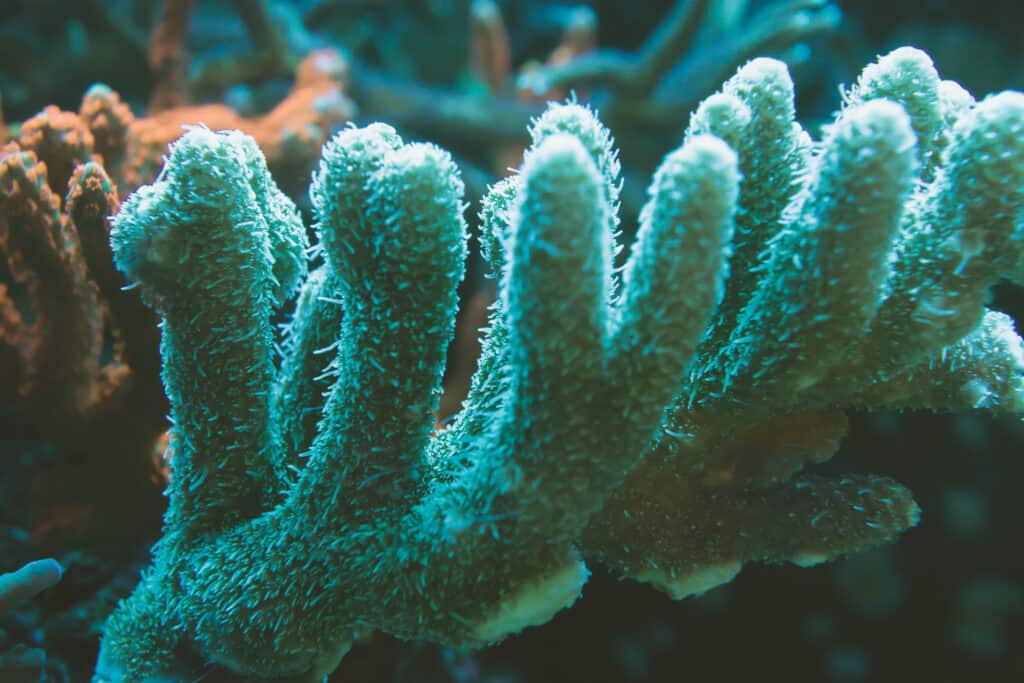Many people don’t know that coral is a living marine animal. Corals are marine invertebrates and members of the same family as sea anemones. There are over 2175 species of coral, and an astonishing 237 of them are endangered species. Scientists believe their near extinction is due to climate change and pollution.
Corals are truly amazing species. They are made of individual polyps that form compact colonies and reefs. Each polyp is an animal only a couple of millimeters in diameter. They have a mouth centrally located on their body and small tentacles. The number of tentacles depends on the species. Soft corals have eight tentacles, and hard corals have six.
Hard corals excrete calcium carbonate that forms a hard skeleton. When many polyps form a colony, their individual skeletons grow together, forming a solid structure many feet long. Hard corals are involved in reef-building, and soft corals look more like colorful marine plants.
Some corals get their food in a unique way. They gain nutrition from single-celled organisms (a type of algae) that live inside their tissues, called zooxanthellae. These organisms also give corals their beautiful bright colors. Some corals can also catch plankton and tiny fish with their tentacles!
To maintain their color, coral needs sunlight and clear water. They live at depths less than 200 feet typically. A great example of a shallow coral colony is the Great Barrier Reef in Australia. The types of coral that do not require zooxanthellae can live in much deeper water, up to 10,800 feet. We will discuss six types of coral in more detail below.
Staghorn Coral (Acropora cervicornis)
Staghorn coral is a hard coral with many branches. The branches are cylindrical in shape and can be up to six feet long. Staghorn coral prefers shallow water under 100 feet deep and provides a safe environment for fish to live.
Staghorn coral reproduces when a branch breaks off and reattaches elsewhere. This breakage is a common occurrence in stormy waters and high winds. They also reproduce by spawning. Each staghorn coral is male and female simultaneously and releases millions of cells into the water that form larvae. The larvae float in the water until they settle into a new colony.
Staghorn corals are threatened by climate change. Because water temperatures are increasing, large coral bleaching events and infectious disease outbreaks are becoming more frequent.

Staghorn coral prefers shallow water under 100 feet deep and reproduces when a branch breaks off and reattaches elsewhere.
©Samuel Blanning – Public Domain
Lettuce Coral (Agaricia agaricites)
Also called tan lettuce leaf coral, this hard coral species also lives in shallow water. It is most at home in shallow lagoons, seagrass meadows, and channels less than 250 feet deep.
Lettuce corals form plate-like structures that look much like lettuce leaves sprouting up from the ocean floor. These sheets form when the coral is small and are arranged in rows with pointy ridges between them. Lettuce coral is purple-brown in color.
Lettuce coral uses zooxanthellae to get up to 95 percent of its energy. These single-celled organisms photosynthesize in the sun and feed the coral. If the coral needs more food, it will expand its tentacles in the evening and trap floating plankton.
Lettuce coral is threatened by rising sea temperatures and pollution but is still a common coral and is not an endangered species.

Lettuce Coral (
Agaricia agaricites) forms plate-like structures that look much like lettuce leaves sprouting up from the ocean floor.
©SergeUWPhoto/Shutterstock.com
Elkhorn Coral (Acropora palmata)
Another type of hard coral is Elkhorn coral which forms reefs in the Caribbean Sea. It is named elkhorn because of its uniquely shaped branches that look like antlers. These branches are an important habitat for many other marine creatures to find shelter.
Elkhorn corals grow quickly, expanding by up to four inches per year. Each branch can get up to six feet long and form reefs over 40 feet wide. They are yellowish brown in color and grow in no more than 16 feet of water. Their beautiful branches interweave to form intricate colonies and support large reefs. These reefs are home to nurseries of baby fish, shelter from predators, and insulation from turbulent water.
Elkhorn corals get most of their nutrition from zooxanthellae, but they can also eat with their tentacles, using them to grab plankton that floats past.
Elkhorn corals reproduce in several ways, similar to the staghorn coral. The colony produces both sperm and egg and releases them into the water to self-fertilize and form larvae. Because this technique only works about fifty percent of the time, elkhorn coral also reproduces by fragmentation. Fragmentation occurs when part of the coral breaks off and floats away to form a new colony.
Elkhorn coral is threatened by disease, climate change, and bleaching. Their numbers have declined severely in several areas of the world.

Elkhorn coral (
Acropora palmata) was named for its uniquely shaped branches that look like antlers.
©iStock.com/johnandersonphoto
Carnation Coral (Nephtheidae)
Carnation coral is also called tree coral, cauliflower coral, and strawberry coral. This brightly colored coral is a soft coral species that comes in a wonderful range of colors, including reds, pinks, purples, and yellows. Carnation coral is a coral you may have seen in an indoor aquarium!
Carnation corals have rubbery branches and do not form a hard exoskeleton. Each branch has a knobby end, which looks a little bit like a flower. Each branch is about eight inches long.
Carnation corals prefer deeper water and live in the northeastern part of the Pacific Ocean at depths up to 8,200 feet. Some even like to grow upside down inside dark sea caves! Carnation coral colonies are the main habitat of sea horses and pipefish.
Carnation coral is a filter feeder. At night it inflates and uses its tentacles to catch floating plankton. It does not have zooxanthellae and relies solely on plankton for food.
Carnation coral reproduces by dropping branches that then form their own roots and start a new colony. Some species of carnation coral also release sperm and egg into the water all year to reproduce. They can also reproduce by a process called budding (or fission) when one polyp splits to form an exact replica that can start its own colony.
Carnation coral is threatened by poor water quality, damage from boats, and flooding events that lower water salinity.

Carnation Coral is a soft coral species that comes in a wonderful range of colors, including reds, pinks, purples, and yellows.
©Mayumi.K.Photography/Shutterstock.com
Bubble Coral (Plerogyra sinuosa)
Bubble coral is often called pearl coral and grape coral. These are all great names because they look like a clump of grapes. Bubble coral doesn’t look like most other hard corals, but it is a stony coral with a hard skeleton under each bubble. Each colony forms an inverted cone shape up to three feet wide. The colony is made of individual bubbles that are one inch wide. Bubble coral is most often tan but also comes in white, brown, and pale green.
Bubble coral lives in shallow environments less than 100 feet and likes warm water, 74 to 83°F. It lives in the western Pacific Ocean, Indian Ocean, and Red Sea. It likes filtered light and can often be found on a cave wall, under an overhang, and out of direct sunlight.
Bubble coral contains zooxanthellate, which it uses to get most of its nutrition. It also deflates its bubbles at night and uses its four-inch-long tentacles to catch plankton.
Bubble coral is threatened by climate change and the destruction of reef habitats.

Despite its appearance bubble coral is a stony coral with a hard skeleton under each bubble.
©iStock.com/stephankerkhofs
Horn Coral (Hydnophora rigida)
Horn corals have many names, including thorny coral, branch coral, knob coral, and deer horn coral. They are made of thin branches that are white or green. They are often fluorescent and can produce their own light!
Horn corals like to live in shallow water less than 100 feet deep and form bushy mounds that have encrusted bases. Each branch is half of one inch thick and looks like it is covered in fur due to its unique skeleton.
Horn coral can be found in many areas, including Australia, Fiji, Africa, and the Phillippines. They are happy in lagoons and other protected reef environments.
Horn corals prefer to spawn during a full moon. They release eggs and sperm in multiple cycles throughout the year in a broadcast method. Once the eggs are fertilized, and larvae form, they settle onto the ocean floor and create new colonies.
Horn corals are threatened by the increasing water temperatures caused by climate change, pollution, and damage from boats and divers.

Horn Coral (
Hydnophora rigida) are often fluorescent and can produce their own light!
©twinsmom/Shutterstock.com
10 INCREDIBLE FACTS ABOUT CORAL
- Coral colonies can live for centuries!
- Carnation coral can grow upside down in a sea cave.
- Coral are animals with mouths and stomachs.
- Coral and jellyfish are cousins.
- Some coral is fluorescent
- Baby coral larvae can swim to find a new home and form their own colony.
- Twenty-five percent of ocean life depends on coral for its survival.
- Corals produce sand for beaches.
- Corals protect the shoreline from waves and floods.
- Climate change is causing ocean temperatures to rise, which bleaches and kills coral.
NEXT UP
The photo featured at the top of this post is © Pink Carnation tree corals/Shutterstock.com
Sources
- ScienceDirect, Available here: https://www.sciencedirect.com/science/article/abs/pii/S0006291X14006834?via%3Dihub
- ScienceDirect, Available here: https://www.sciencedirect.com/science/article/abs/pii/S1055790313002601?via%3Dihub
- Wikipedia, Available here: https://en.wikipedia.org/wiki/IUCN_Red_List
- National Library of Medicine, Available here: https://www.ncbi.nlm.nih.gov/pmc/articles/PMC7202597
- International Union for Conservation of Nature’s Red List of Threatened Species, Available here: https://www.iucnredlist.org/species/133535/3791008
- Coral Reef Restoration Handbook, William F. Precht, Available here: https://books.google.ca/books?id=-AHOBQAAQBAJ&printsec=frontcover#v=onepage&q&f=false
- Latin American Coral Reefs, Z.M.A.N. Leão et al, Available here: https://books.google.com/books?id=LLlwoNsqxi0C&pg=PA40
- National Library of Medicine, Available here: https://www.ncbi.nlm.nih.gov/pmc/articles/PMC5047146
- Wiley Online Library, Available here: https://onlinelibrary.wiley.com/doi/full/10.1111/aec.13160
- NOAA Fisheries, Available here: https://www.fisheries.noaa.gov/insight/ocean-acidification
Thank you for reading! Have some feedback for us? Contact the AZ Animals editorial team.






